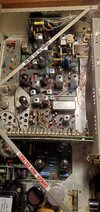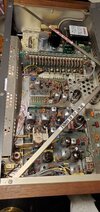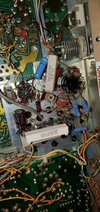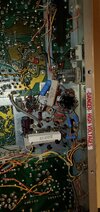Just picked up a d201a and was using it for a while seemed to be going alright then just the am recieve dropped to zero. Ssb seems to have a normal amount of noise in the reciever. Seems to have been gone through at one point or another my RadioShack pep Meter Reads about 30w pep on am not as much on ssb however. Not sure what to do with this old Lincoln of a radio. Would love to have it fully operational and on the air on a regular basis. Was offered it and a 201 by a friend who passed and it has sentimental value to me given he was the first person local I chatted with when I entered this hobby. Any help is appreciated. For the moment I'm just dealing with the 201a. Will be picking up the 201 shortly didn't notice whether it was the hardwired model or not. This one says made in Mexico. Any photos I can take to help steer me in the right direction just let me know.
You are using an out of date browser. It may not display this or other websites correctly.
You should upgrade or use an alternative browser.
You should upgrade or use an alternative browser.
-
You can now help support WorldwideDX when you shop on Amazon at no additional cost to you! Simply follow this Shop on Amazon link first and a portion of any purchase is sent to WorldwideDX to help with site costs.
D201a no am receive.
- Thread starter bigred222
- Start date
Also did notice the other lengthy thread on a user's standard d201 not sure what does and doesn't apply to the 201a especially given my radio life has been geared towards all solid state equipment.
Seems as if all tubes say tram on them with the exception of the largest one closest to the transformer and the one directly south of it given your perspective is from the front of the radio.
Do you have a manual or schematic for it? If not, you can download them here: https://web.archive.org/web/20210302170832/http://cbtricks.com/radios/tram/d201a/index.htm. There are board diagrams in the manual that will help you identify the parts. Looks as though most of the resistors that normally cause that and other problems have been replaced. It could be crystal X301on the receiver board. It is for AM receive only. If you measure the voltage at pin 1 of V301 (it should be around 110vdc). Then pull the crystal and if the voltage doesn't change, then X301 most likely is dead. If the voltage is low at pin 1, R322 could be bad, but I see it was replaced. You might check the voltage at pin 2 of V300. It should be about 125vdc. If it is low, R302 or R303 may be bad. I see they are still original. It may just be a tube not making a good connection in its socket. Many times in those radios, the tubes will be loose in the sockets. The spring clips will lose their tension over time and lose contact with the tubes' pins. They may also just need to be cleaned. You can use alcohol or contact cleaner to clean the pins and sockets. It could just be it needs a new tube or tubes, since they are mostly original. A tube tester would help identify the weak or bad ones. Might also check for poor soldering on the underside of the board.
Very nice Tram. Someone did a good job visually with a nice update/ restore. I am losing sleep trying to get my #13561 point to point N.H. made d201 going.Good luck!
Thank you for the help it's much appreciated. It did come back finally and has been doing well otherwise. I'll probably be able to get it over to a very competent tram tech I know in the near future. And hopefully it'll get in a bit better operational condition. Been talking quite a bit of skip with it. I believe the radios bias may be out of adjustment per what I see and given what I tell my friend I am seeing and his input on what I'm seeing means. The tube in the rear of the radio nearest to the power transformer starting glowing a blue color. So I am going to try to get it to his bench to give it a once over. Other than that it seems to be transmitting with good clear "running as it should" audio. I did shoot him a photo or two back and forth and we discovered why the radio has such a high carrier output on am. A resistor that stems off of the tube in the output section was changed to that of a lower value thus given a higher than normal carrier. Letting the beast rest until it gets a check up from the tech and it will also help drive my modulator properly which in turn will not make my 8950s get knocked so hard and try to get that 25% carrier of my total output power right. It's 2023 tubes aren't easy to come by anymore and the ones I have are old obviously but in good operational condition and I'd prefer to keep them that way for as long as possible.Do you have a manual or schematic for it? If not, you can download them here: https://web.archive.org/web/20210302170832/http://cbtricks.com/radios/tram/d201a/index.htm. There are board diagrams in the manual that will help you identify the parts. Looks as though most of the resistors that normally cause that and other problems have been replaced. It could be crystal X301on the receiver board. It is for AM receive only. If you measure the voltage at pin 1 of V301 (it should be around 110vdc). Then pull the crystal and if the voltage doesn't change, then X301 most likely is dead. If the voltage is low at pin 1, R322 could be bad, but I see it was replaced. You might check the voltage at pin 2 of V300. It should be about 125vdc. If it is low, R302 or R303 may be bad. I see they are still original. It may just be a tube not making a good connection in its socket. Many times in those radios, the tubes will be loose in the sockets. The spring clips will lose their tension over time and lose contact with the tubes' pins. They may also just need to be cleaned. You can use alcohol or contact cleaner to clean the pins and sockets. It could just be it needs a new tube or tubes, since they are mostly original. A tube tester would help identify the weak or bad ones. Might also check for poor soldering on the underside of the board.
The kid in ct on my trashy tram is out.
Underside of it has been modified obviously. Going to try to get it back in original condition to preserve tube life.Very nice Tram. Someone did a good job visually with a nice update/ restore. I am losing sleep trying to get my #13561 point to point N.H. made d201 going.Good luck!
Attachments
The original D201 was built in Winnisquam New Hampshire with point-to-point construction, the tube sockets all mounted in holes punched into the metal chassis deck. The parts were strung from tube socket lugs to tie strip lugs, in open air. Easy to identify this version from the outside. Has a knob labeled "VOX" next to the mike socket. The labor to mount and solder all the parts this way proved too expensive, so it was redesigned to use large printed-circuit boards that host all but two of the tubes. The VOX feature was eliminated and a variable ANL knob took its place. Soon after this production moved to a partly-subsidized "maquiladora" factory in Mexico just south of the border. The info at CB Tricks covers the original version with the "VOX" control on the front, and the 40-channel D201A. Sadly, a diagram for the in-between 23-channel circuit-board radio is not posted there.
Oops.
The radio runs kinda hot inside, with all those tubes. This accelerates the aging of electrolytic capacitors. Those were never meant to last 20 years, let alone 40-plus, so replacing them all will avoid playing "whack a mole" as they fall like a row of dominoes.
Bear in mind that BLUE seen on the surface of the glass is just what happens when the glass recipe gets contaminated by phosphorus compounds. Doesn't signify any trouble on the inside of the tube. What you don't want to see is the color purple coming from inside the tube. That would indicate the vacuum is contaminated with gas.
This radio was treated as a hot rod by a lot of owners, and the range of modifications seems near infinite. Some of them good, some not so good and others just so-so.
A tube CB base is a bit like a tube guitar amp. If that's what you like, you won't be happy with a substitute.
73
Oops.
The radio runs kinda hot inside, with all those tubes. This accelerates the aging of electrolytic capacitors. Those were never meant to last 20 years, let alone 40-plus, so replacing them all will avoid playing "whack a mole" as they fall like a row of dominoes.
Bear in mind that BLUE seen on the surface of the glass is just what happens when the glass recipe gets contaminated by phosphorus compounds. Doesn't signify any trouble on the inside of the tube. What you don't want to see is the color purple coming from inside the tube. That would indicate the vacuum is contaminated with gas.
This radio was treated as a hot rod by a lot of owners, and the range of modifications seems near infinite. Some of them good, some not so good and others just so-so.
A tube CB base is a bit like a tube guitar amp. If that's what you like, you won't be happy with a substitute.
73
dxChat
- No one is chatting at the moment.
-
-
dxBot:63Sprint has left the room.
-
dxBot:kennyjames 0151 has left the room.
-
-




